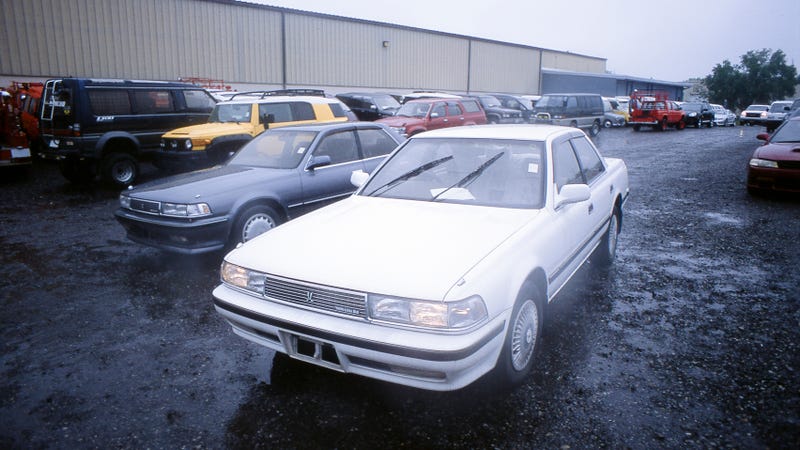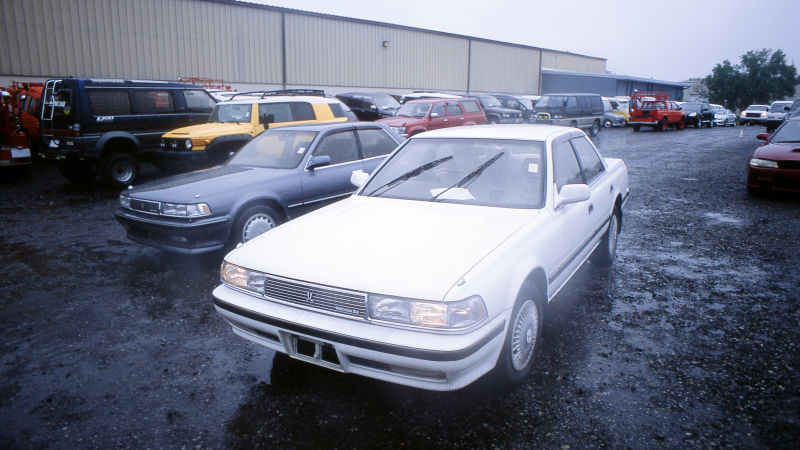
The problem with the second one was that it might be cursed. The problem with the first one was that it might be perfect. I finally got to drive two 1990s Toyota Crestas, dream cars of mine never originally sold in the United States, in the hopes that they’d disappoint me and I’d stop wanting to buy one. I didn’t luck out.
A couple of months back, I went down with a bunch of my coworkers to Christiansburg, Virginia. We were not going there for the barbecue. We were going to see Gary Duncan of Duncan Imports and shoot a handful of videos on the greatest, strangest cars of Japan’s Bubble Era.
In between two of those shoots, I darted away to try to drive what I kept calling “my car.” It was a 1990 Toyota Cresta, refrigerator white, looking every bit like… not much at all.
Advertisement
Indeed, it looked a lot like the refrigerator white 1992 Toyota Camry that I learned to drive in. The difference is that the Camry I once slowly drove into a fence while parking, forever denting the hood, was a four-cylinder automatic with front-wheel drive. The Cresta was rear-wheel drive, with a straight-six, and a manual transmission. Also, the interior was door-to-door brown and every seat had a lace cover. Nice.
Less nice: a bunch of hornets made a nest in the door jamb, right by the driver’s seat.
Advertisement

You can actually see in the photo above that I attempted to take a picture of the aforementioned lace covers until I realized I was being surrounded by angry hornets and I immediately hustled away.
Advertisement

Then I realized that there were more hornets. Farther back for a photo-op, then.

Advertisement
I had no reason to fear, Duncan Imports’ staff told me. They’d clear those hornets out no problem. While I was waiting, though, there’s this other 1990 Toyota Cresta sitting right here ready to go. Want to test that out too? This one has the twin-turbo engine.
Ah.
Yes.
Very.

Advertisement
This grey car had the demerit of being an automatic, but the bonus of having one of the more interesting forgotten engines of the modern age. Before the 2JZ and 1JZ, there was this, the 1G-GTE.
Advertisement
It’s a 2.0-liter six, just like in the white car, and it’s a Yamaha-designed piece of work. Yamaha is beloved in the car world for its automobile engines, like the four-cylinder Toyota 4A-GE that made the AE86 a legend, the howling V6 that made the Taurus SHO a cult classic, or the screaming V10 that made the Lexus LFA a legend. The 1G-GTE isn’t just a sweet twin-cam; it’s twin-turbocharged. And this was the very first series production car with twin turbos. It comes after the limited-production Porsche 959 and before the sequential twin-turbo Mazda rotaries in the FD RX-7 and the Eunos Cosmo.

Advertisement
So what’s it like to drive what’s ostensibly a low-mile Camry but with a turbo straight-six and rear-wheel drive? It feels strong. It pulls. It stops short of being fast. I mean, I got passed by a Prius at one point, but the car has the feeling of torque, of urge. It feels solid, like it wants to run for a million miles, a throaty grumble from under the hood, along with a double whirr from the turbos. I wanted it. I wanted it bad.
Then I looked at the engine itself.
Ah.
Yes.

Advertisement
That is a lot of plumbing for those two old turbos. And a lot of vacuum lines. It’s a lot to look after in general. Rather, it is not something that I would ever dream of maintaining, no matter how life-affirming the sound, the urge that the engine gave. At least that’s what I told myself.

Advertisement
For every moment that I was in the Cresta, all I thought about was how reliable these cars are. Everything felt well-made. The doors. The seats. The digital dash. Even the air-con controls that pop out with the press of a button from behind a hidden panel.

Advertisement
Every moment that I was out of the Cresta, all I could think about was how sure I was that these parts would eventually break. Sure, this is a car from the absolute peak of Japanese over-engineering. But even a Bubble Era in-dash heater control motor is going to conk out at some point, and I don’t want to go through all of the clips to pull the dash apart to fix it when it inevitably whirrs its last whirr.

Advertisement
And then the white car rolled up, as the rain grew heavy. Tires pumped back up. No more hornets.

Advertisement
But a combination of a very dead battery and what seemed like some old gas meant that the manual, naturally-aspirated car didn’t want to do much more than go around the block and then sputter to a quiet shut-down. All I got to do was feel a bit of the power. It’s not a lot. About 150 horsepower pulling around 2,800 pounds. But the sound of a small, twin-cam straight-six is a joy. So smooth, so confident, so addictive.

Advertisement

I’ve owned a six-cylinder Toyota of this era before. That car was a wonder.
Advertisement
Juggling two-car ownership in New York City was a nightmare, especially when they were broken. I can’t go down this road again, I tell myself, looking back over the for sale-listings for the hundredth time.














